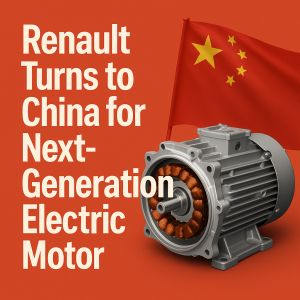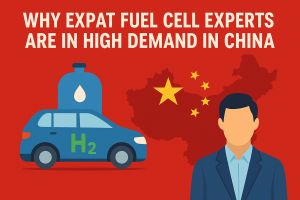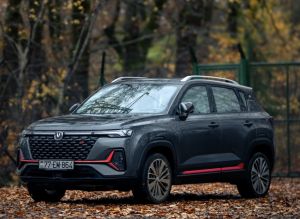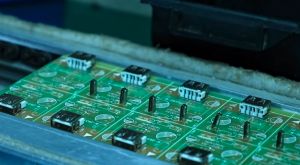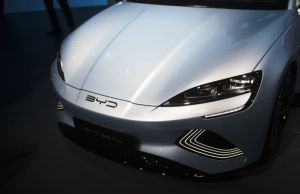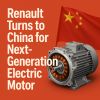Test Owner
Renault has decided to end its joint project with Valeo to develop a rare-earth-free electric vehicle motor and is now seeking a lower-cost Chinese supplier to help drive its next generation of EVs.
The move highlights the growing dominance of Chinese technology and manufacturing in the global electric vehicle industry. As the cost of electrification continues to pressure European automakers, China’s scale, speed, and affordability have become increasingly attractive.
Renault’s new motor, internally known as the E7A, was initially being developed in partnership with Valeo as part of a plan to design a more compact, more powerful motor without rare earth materials. The project will now be managed entirely within Renault, with the exception of the stator, which may be sourced from a Chinese manufacturer.
This shift marks another step in Europe’s quiet reliance on Chinese suppliers for critical EV components. Chinese companies currently lead the world in battery technology, magnet-free motor design, and cost-efficient production — advantages that have proven difficult for European firms to match.
Renault is expected to keep final assembly of the motor in France, at its Cleon plant, while still integrating Chinese-made parts. The motor will use advanced silicon carbide modules from STMicroelectronics and deliver around 200 kW of power, a 25% improvement over current Renault electric models.
The French automaker has increasingly turned to China for engineering expertise. A Chinese development team played a key role in designing the new electric Twingo, reducing its production timeline to just two years.
The upcoming E7A motor will power Renault’s next generation of compact EVs starting in 2028, a central part of its long-term electrification strategy. With China’s influence continuing to expand across the EV supply chain, Renault’s decision signals how deeply interlinked European automakers have become with Chinese innovation — not just for batteries, but now for core powertrain technology.
China is racing to build the world’s largest hydrogen economy — and it needs help to do it. As Beijing pushes toward its carbon neutrality target for 2060, investment in hydrogen and fuel cell technology is accelerating. But despite its rapid progress, China still faces gaps in technical know-how. This is where expat fuel cell experts come in. Across the country, foreign engineers, scientists, and technical managers are being hired to help Chinese companies bridge those gaps and turn research projects into large-scale commercial solutions.
Rapid Market Growth
China’s hydrogen economy is growing faster than any other in the world. Government subsidies and local pilot programs are targeting fuel cell vehicles (FCVs), particularly heavy-duty trucks, buses, and port vehicles.
In 2024, over 8,000 fuel cell vehicles were deployed in China — the highest annual number yet — with cities like Shanghai, Foshan, and Beijing leading the rollout.
The government’s 2030 target calls for one million FCVs on the road and a fully developed hydrogen supply network.
This aggressive scaling requires expertise that local teams are still developing — creating a huge talent gap.
Where the Expertise Is Needed
Foreign specialists are being hired for several critical areas:
Core Components: Experts in bipolar plates, hydrogen compressors, and precision hydrogen filling systems are helping manufacturers boost stack performance and reduce costs.
Advanced Materials: China is still catching up to global standards for high-grade plastics, membranes, and carbon fiber composites used in fuel cell stacks and hydrogen tanks.
Durability & Reliability: International experts are improving the life cycle of stacks — a key factor for commercial trucks, which require tens of thousands of operational hours.
System Integration: Large-scale projects need foreign engineers with experience designing full fuel cell engine systems, control software, and safety systems.
Commercialization: Many Chinese R&D projects have struggled to leave the lab. Foreign managers are often hired to close this “valley of death” between research and market-ready products.
Knowledge Transfer & Standards
Expat experts are not just filling jobs — they’re training local teams. Roles such as stack durability specialists and fuel cell control engineers are often filled by foreign hires who then build up local knowledge.
International hires are also helping shape industry standards and safety regulations, an area where China is still developing frameworks to align with global markets.
Foreign Players Driving Demand
Global partnerships are further increasing the need for expat talent:
Ballard Power Systems (Canada) has joint ventures in China, supplying fuel cell stacks for commercial vehicles and employing international engineers to oversee production quality.
Bosch and Weichai Power are co-developing fuel cell systems in Shandong Province, with German specialists leading early production phases.
Shell is building hydrogen fueling infrastructure in key cities, bringing in experts to manage station design and safety compliance.
The Bottom Line
For China, importing talent is a fast way to catch up with Japan, South Korea, and Europe in fuel cell technology. For foreign engineers and technical managers, the demand translates into attractive salaries, relocation packages, and opportunities to work on some of the world’s largest hydrogen projects
Toyota Motor Corp. achieved record global sales in July, extending its growth streak to a seventh consecutive month, as robust demand in the United States and China helped offset challenges from slowing domestic sales and intensifying trade pressures.
Including subsidiaries Daihatsu Motor Co. and Hino Motors Ltd., Toyota sold 963,796 vehicles worldwide last month, a 4% increase from the previous year. Global production also rose 2.6% to 947,943 units. While sales in Japan slipped 2%, overseas demand surged 6%, underlining the importance of international markets to the automaker’s performance.
North America remained a key growth driver. Toyota and Lexus models saw a 20% sales jump in the region, powered by consumer appetite for SUVs, pickup trucks, and hybrid vehicles. In China, Toyota’s second-largest market, sales rose 5.7%, supported by steady demand for hybrids despite growing competition from local electric vehicle makers.
The strong performance comes against the backdrop of heightened trade uncertainty. Earlier this month, Toyota warned of a ¥1.4 trillion ($9.5 billion) blow to its earnings from tariffs imposed by U.S. President Donald Trump on imported cars and parts. The company has trimmed its full-year operating profit forecast to ¥3.2 trillion for the fiscal year ending March 2026, down from its initial ¥3.8 trillion projection. Although Japanese automakers avoided a 25% tariff, the current 15% duty remains a significant headwind for sales in their largest overseas market.
Rivals posted mixed results in July. Honda Motor Co. saw global sales fall 7.6% to 279,727 vehicles, weighed down by a sharp slowdown in China, with production also dropping 7%. Nissan Motor Co., by contrast, eked out growth for the first time in 16 months. Its sales rose 0.5% to 262,745 vehicles, buoyed by a 22% surge in China, where its fully electric N7 model has gained traction with consumers seeking affordable EVs.
Beyond tariffs, Japanese automakers face a broader challenge: the accelerating global shift toward battery-electric vehicles. Toyota, which has leaned heavily on hybrid technology, has benefited in the short term from surging hybrid demand. But rivals such as China’s BYD Co. and Tesla Inc. are dominating the fast-growing EV segment with models that increasingly set the pace in innovation, affordability, and scale.
Analysts say Toyota’s July results highlight both its resilience and the urgency of adapting to an industry in transition. Strong hybrid sales and loyal demand for Toyota’s SUVs and trucks have helped the company weather geopolitical and economic headwinds. Yet the longer-term question is whether the world’s largest carmaker can maintain its lead as the global auto industry pivots toward full electrification
Chinese automaker Changan is planning to establish a manufacturing plant in Europe to support its growing sales ambitions on the continent, a senior executive told Reuters on Wednesday.
“We're committed to being in Europe, making in Europe for Europe,” said Nic Thomas, Changan's European head of marketing, sales, and service. Speaking during a test drive event for the company’s electric Deepal S07 SUV near London, Thomas confirmed that the company is actively exploring locations for the factory.
While he declined to provide a timeline for the facility’s construction, Thomas said Changan is confident in reaching sales volumes that would justify local production. “We're already in the planning stages,” he added.
Changan announced in March that it aims to launch electric vehicles in 10 European markets this year. In the UK, the company plans to begin selling the Deepal S07 later in 2024, with customer deliveries starting in September.
Globally, Changan ranked as the 16th largest automaker in 2024, selling just over 2.2 million vehicles, according to automotive analyst Felipe Munoz. Of those, around 600,000 were sold outside China. This year, Changan aims to grow that figure to 1 million.
The company joins a growing list of Chinese automakers expanding into Europe. BYD (002594.SZ) and Chery (CHERY.UL) have already entered the European market and announced plans for local production. BYD is constructing an EV plant in Hungary, while Chery plans to build cars in Spain through a partnership with local firm Ebro.
In a related development, Geely (GEELY.UL) announced on Wednesday that it is launching its namesake brand in the UK, with its first offering being the electric EX5 SUV.
China's semiconductor industry is undergoing a critical transformation—one shaped by technological ambition, national security imperatives, and the high-stakes pressure of great power competition. Once reliant on imports and foreign partnerships, China is now sprinting toward a future where self-sufficiency in semiconductor design and fabrication is not just a goal but a necessity.
The Semiconductor Sector: Strategic and Surging
Often described as the “brains” behind digital devices, semiconductors are vital to everything from smartphones and electric vehicles to AI, cloud computing, and military systems. The COVID-19 pandemic and escalating U.S.-China tech rivalry have only reinforced just how indispensable—and vulnerable—chip supply chains are.
Despite decades of development and major state-backed investment programs like the Big Fund and Made in China 2025, China still lags in high-end chipmaking, especially in advanced lithography and fabrication. But the tide is turning.
As of 2023, China accounted for 16% of global chip production and is expected to hit 50% self-sufficiency by 2025, mainly in mature nodes and specialty applications. Companies such as SMIC, HiSilicon, Hua Hong Semiconductor, YMTC, and CXMT are pushing forward on multiple fronts—from memory and AI chip design to etching, thin-film deposition, and packaging.
China has also become the world’s top investor in semiconductor equipment, projected to spend over $100 billion between 2024 and 2027. Semiconductor exports, despite foreign restrictions, grew over 20% in 2024. Domestic innovation is now surging, with R&D driving improvements in photoresist stripping, cleaning, etching, and CMP (chemical mechanical planarization).
But one massive bottleneck remains: talent.
The Growing Need for Process Integration Engineers
In the heart of every fabrication facility lies the challenge of integrating hundreds of steps—photoresist coating, etching, implantation, lithography, polishing—into a cohesive, high-yielding, and scalable production process. This complexity makes Process Integration Engineers indispensable.
These professionals oversee the seamless coordination of materials, tools, design rules, and device structures. As chips become more powerful, smaller, and more specialized, process integration becomes exponentially more difficult—and more valuable.
With China pushing for breakthroughs in 28nm and 14nm process nodes under tight export controls, and even attempting 7nm production under sanctions, the demand for elite process integration engineers is soaring.
Why R&D Technical Process Integration Engineers are Key:
Technology Bridging: They connect front-end and back-end processes, ensuring chip functionality across design, materials, and production workflows.
Yield Optimization: They identify and solve process bottlenecks, improving yields and reducing production costs.
Innovation Acceleration: Their R&D insights help tailor fabrication methods for new chip architectures (AI chips, 3D NAND, etc.).
Localization Strategy: They are central to developing domestic alternatives to foreign technologies and equipment.
Cross-Functional Synergy: Integration engineers work across device design, materials science, and production engineering teams, making them vital to ecosystem-wide efficiency.
Strategic Talent for a Strategic Industry
China’s semiconductor future hinges as much on people as on policy. Despite hundreds of billions in capital investment, without top-tier engineering talent—particularly in R&D and process integration—advanced domestic chip manufacturing will remain a distant goal.
China’s current talent shortfall in semiconductor engineering is estimated in the hundreds of thousands. Universities are expanding STEM programs, and firms are aggressively recruiting talent from Taiwan, Europe, South Korea, and beyond. Yet the demand continues to outstrip supply.
If you are a specialist in semiconductor process integration—especially with experience in front-end fabrication, lithography, or device yield optimization—there’s never been a better time to make a meaningful impact.
Join the Front Lines of Technological Advancement
China’s semiconductor industry is no longer a follower—it’s an assertive competitor. At this pivotal inflection point, the contributions of skilled engineers will define not just corporate success, but national capacity.
If you’re an R&D Technical Semiconductor Process Integration Engineer ready to be part of the next phase of global semiconductor innovation, we invite you to explore current opportunities in China’s fast-evolving industry.
???? Submit your CV and browse active roles at: https://www.icautochina.com/job-search/28-r-d-technical-semiconductor-process-integration-engineer-contract-job-china/semiconductor-rd-engineering/chongqing/job
China’s Motorcycle Industry: A Quiet Revolution and the Rising Need for Motorcycle Layout Design Engineers
For decades, China's motorcycle industry was the punchline of many jokes in Western markets—synonymous with cheap knock-offs, questionable quality, and bike names that inspired more laughs than confidence. Yet, those stereotypes are quickly aging out of relevance. The Chinese motorcycle industry is undergoing a transformation that mirrors what Japan experienced in the 1960s and 70s—a rise from ridicule to respect.
The Evolution of the Chinese Motorcycle Industry
Today, China’s motorcycle manufacturing capabilities are maturing rapidly. What was once an industry focused on producing low-cost, disposable machines for domestic and emerging markets is now evolving into one capable of delivering high-performance, high-quality motorcycles that can compete globally.
This transformation isn’t occurring in isolation. Chinese manufacturers are drawing from decades of experience in producing for foreign brands. Loncin has been making engines for BMW for nearly 20 years. CFMoto operates a joint venture with Austrian giant KTM. Zongshen works closely with Italy’s Piaggio. These partnerships have honed the engineering and manufacturing capabilities of China’s motorcycle industry, building a foundation of quality and trust.
Now, brands like CFMoto, Voge, Benelli (owned by Qianjiang Group), Kove, and QJ Motor are stepping into the spotlight with larger displacement models, refined engineering, and export ambitions. They are shifting their focus to premium segments and investing heavily in electric mobility, where China already holds a strong lead.
Market Dynamics and Challenges
Despite this progress, the road ahead isn’t without obstacles. The start of 2025 saw a 2.9% drop in overall new motorcycle registrations in China, with just under 3 million units sold in Q1. The electric segment—long considered a strength—has plateaued, and even market leader Yadea has seen a decline. This stagnation is driven by multiple factors:
Urban Restrictions: Major cities are clamping down on two-wheeler usage to reduce accidents and pollution, pushing consumers toward public transportation and cars.
Rising Incomes: As China’s middle class grows, many are opting for cars, leaving small-displacement motorcycles behind.
Shifting Preferences: A new generation of riders now sees motorcycles less as essential transport and more as lifestyle or leisure products. This has driven demand for more advanced, stylish, and powerful bikes.
Interestingly, while volume is falling, value is rising. The sub-250cc segment is shrinking, but the premium (>250cc) category is growing rapidly. This suggests that the domestic market, though contracting in size, is upgrading in quality.
The Strategic Shift to Electric and Premium Segments
Electric motorcycles and scooters, long dominant in China, are now evolving from basic urban commuters into higher-spec, high-performance machines. The current downturn in electric vehicle (EV) sales is not a sign of failure, but rather a reflection of transition. Manufacturers are pivoting toward a new generation of electric two-wheelers with improved battery technology, extended range, and better performance—more aligned with consumer expectations in both domestic and export markets.
This strategic shift—from quantity to quality, from cheap to premium—demands a different kind of engineering. It is no longer enough to assemble bikes from generic parts. The next wave of motorcycles must be well-designed from the ground up, with a strong focus on aesthetics, rider ergonomics, chassis dynamics, and component integration.
The Need for Motorcycle Layout Design Engineers
This is where the Motorcycle Layout Design Engineer becomes essential.
As Chinese brands venture into premium and performance segments, they must deliver machines that compete not just on price, but on ride quality, durability, comfort, and style. A Motorcycle Layout Design Engineer plays a crucial role in this evolution:
Conceptual Design Integration: Translating market trends and consumer preferences into a coherent bike design layout—balancing ergonomics, packaging, and aesthetics.
Mechanical and Structural Planning: Coordinating the placement of powertrains, batteries, suspensions, and other components for optimal weight distribution and performance.
Multi-disciplinary Collaboration: Working with electrical, software, and industrial designers to ensure a cohesive product—especially important in electric motorcycles.
Cost and Manufacturability Optimization: Ensuring that the final design meets the required performance benchmarks and can be produced efficiently at scale.
In short, layout engineers are the glue between artistic vision and mechanical execution. As Chinese brands look to challenge Japan, Europe, and America, they need top-tier design talent to guide the development of motorcycles that don't just work, but inspire loyalty and enthusiasm.
Conclusion: A New Chapter, A New Talent Demand
The Chinese motorcycle industry is entering a pivotal phase. It is leaving behind its "cheap and cheerful" reputation and embracing a more ambitious future—aiming to produce not only cost-effective machines but also desirable, premium, and sustainable motorcycles for global riders.
To achieve this, the industry must invest in design and engineering talent—particularly in layout design, which underpins the rider experience. Motorcycle Layout Design Engineers will be at the heart of China’s two-wheeled renaissance, shaping the machines that will define the next generation of mobility.
The question is no longer whether China can build world-class motorcycles—it’s who will help design them. If you are a specialist in motorcycle layout design or related engineering disciplines and want to make a real impact in the next phase of two-wheeled and electric mobility innovation, we invite you to explore current opportunities. Submit your CV for active roles in this rapidly evolving sector at: https://www.icautochina.com/job-search/24-motorcycle-layout-design-engineer-contract-job-china-must-have-over-400c-expert/senior-engineering-expat-contracts/baoding/job
Tensions between two of China’s leading automakers have boiled over, with BYD pushing back against remarks from Great Wall Motor’s chairman, who warned that China’s auto industry is entering an “unhealthy” phase due to a deepening price war.
Shares of major Chinese automakers, including BYD, Nio, and XPeng, fell this week following comments by Great Wall Motor Chairman Wei Jianjun. Wei raised alarms over the industry’s deteriorating profitability, likening the situation to the collapse of Evergrande, the heavily indebted property developer that was liquidated last year. He did not name specific companies in his warning.
BYD's head of branding and public relations, Li Yunfei, publicly dismissed Wei’s remarks as alarmist. In a post on Weibo, Li stated there was no crisis comparable to Evergrande’s among China’s leading automakers and expressed confusion over online speculation that Wei’s comments were aimed at BYD.
Li defended BYD’s financial position, noting the company’s 70% debt-to-asset ratio and more than 580 billion yuan in debt. He argued that such figures were normal for a fast-growing company and drew comparisons with international giants like Ford, Boeing, and Toyota—without mentioning specific competitors in China.
He also warned that BYD would pursue legal action against individuals spreading misinformation online and claimed to have submitted evidence to Chinese authorities.
Great Wall Motor has yet to respond to requests for comment.
Despite growing concerns, China’s auto price war shows little sign of easing. This week, multiple automakers followed BYD’s lead by introducing new discounts and promotions in an effort to maintain sales momentum.
Wei’s views have found some support within the industry. Changan Chairman Zhu Huarong echoed the sentiment during a shareholder meeting on Tuesday, stating that Wei’s comments served as a cautionary message about growing risks in the market, according to local media.
The rivalry between BYD and Great Wall is not new. In 2023, Great Wall Motor reported BYD to Chinese regulators, alleging its top-selling hybrid vehicles failed to meet emissions standards. BYD later called for the domestic auto industry to unite and “demolish the old legends” of the global car market—remarks that drew a pointed response from Great Wall.
The Rise of Proton Exchange Membrane Fuel Cells — And the Growing Need for Control System Experts in China
As nations intensify efforts to combat climate change, the global spotlight is increasingly focused on hydrogen as a clean energy carrier — and Proton Exchange Membrane (PEM) fuel cells are emerging as a leading technology in this transition. With high energy efficiency, scalability, and zero emissions at the point of use, PEM fuel cells are seeing growing adoption across transportation, industrial, and energy sectors.
In particular, China is becoming a major hub for PEM fuel cell development, creating an urgent and rapidly expanding demand for specialized talent — especially Fuel Cell Control Experts.
What Are PEM Fuel Cells and Why Do They Matter?
Proton Exchange Membrane (also called Polymer Electrolyte Membrane) fuel cells generate electricity through an electrochemical reaction between hydrogen and oxygen, producing only water and heat as byproducts. Unlike combustion engines, PEM fuel cells operate silently, emit no pollutants, and offer a fast response to load changes, making them ideal for mobile and distributed energy applications.
They are especially suitable for:
Fuel cell vehicles (FCVs) — buses, trucks, and cars
Backup and off-grid power systems
Material handling equipment like forklifts
Portable and military power solutions
Why the Sector Is Booming
1. China’s Hydrogen Push
China has made hydrogen a strategic priority in its national energy strategy. Cities and provinces are rolling out ambitious hydrogen roadmaps, aiming to build thousands of hydrogen refueling stations and put tens of thousands of FCVs on the road by 2030.
This aligns with China’s dual goals of reducing urban air pollution and achieving carbon neutrality by 2060.
2. Government Incentives and Industrial Policy
Generous government subsidies, infrastructure investment, and joint ventures between domestic firms and global fuel cell companies have accelerated technology deployment and commercial adoption.
3. Decentralized Energy Systems
PEM fuel cells are being adopted beyond transportation, including in telecom towers, residential buildings, and emergency backup systems — all of which benefit from clean, quiet, and reliable energy.
The Critical Need for Fuel Cell Control Expertise
As PEM fuel cell systems become more widespread and complex, their performance, safety, and reliability hinge on advanced control systems.
Fuel Cell Control Experts are vital in the following ways:
System Optimization: They design and fine-tune the balance of plant (BoP) — including air supply, cooling, and hydrogen management.
Safety Management: They implement fault detection, thermal control, and pressure regulation to prevent system failure.
Software & Embedded Systems: Experts develop real-time control algorithms and integrate software with the fuel cell stack, vehicle systems, or grid interfaces.
Diagnostics & Prognostics: Predictive maintenance and degradation modeling are crucial for system longevity and commercial viability.
As systems scale from lab prototypes to mass-market deployment, the sophistication of control architecture becomes a make-or-break factor.
Talent Gap and Industry Implications
Despite the urgency, there is a global shortage of professionals with deep experience in PEM fuel cell control — particularly in China, where demand has outpaced local training and expertise development. Many companies are:
Expanding internal training programs
Partnering with universities and research institutes
Recruiting internationally to fill knowledge gaps
The pressure to commercialize fuel cell vehicles and infrastructure within tight policy timelines is intensifying the need for skilled engineers, especially those with cross-disciplinary knowledge in electrochemistry, control systems, embedded hardware, and software integration.
What’s Next?
As the energy transition accelerates, PEM fuel cell control experts are becoming indispensable across industries. Their work not only ensures system safety and efficiency but also enables scalability — which is critical for widespread adoption.
In the coming years, we can expect:
Increased international collaboration to address talent shortages
Growing investment in education and upskilling programs
More career opportunities in hydrogen hubs like China, Germany, Japan, and the U.S.
Proton Exchange Membrane fuel cells are no longer emerging tech — they’re becoming a core component of the clean energy landscape. As China and other major economies push forward with hydrogen infrastructure and fuel cell vehicle deployment, the demand for control system expertise will only intensify.
For engineers, researchers, and technologists, now is the time to engage. The future of clean energy will be shaped not only by chemistry and hardware — but by the software and control systems that make PEM fuel cells run safely, efficiently, and at scale.
If you are a specialist in this field and looking to make a meaningful impact in the next phase of clean energy innovation, we invite you to explore current opportunities. Submit your CV for active roles in this sector at: https://www.icautochina.com/job-search/22-fuel-cell-sealing-expert-contract-job-china/senior-engineering-expat-contracts/baoding/job
R&D Engineers with Doctoral Degrees in China: Driving Innovation and Technological Leadership
China is accelerating its emergence as a global technological powerhouse, largely driven by an ambitious surge in research and development (R&D) capacity. At the heart of this transformation is a rapidly expanding class of STEM PhD holders, many of whom are shaping the future of automotive innovation and other advanced industries.
While China’s progress inspires admiration, it also raises questions among international observers — particularly in the United States — about the implications for global technological leadership, economic security, and national competitiveness.
A Surge in STEM PhDs: Quantity with Rising Quality
According to a 2021 report by Georgetown University’s Center for Security and Emerging Technology (CSET), China is expected to produce over 77,000 STEM PhDs annually by 2025, nearly twice the number of the U.S., and more than triple when excluding U.S. international students. This rapid expansion is the product of deliberate national strategy: since the early 2000s, China has opened over 1,300 new PhD programs and nearly doubled its higher education budget between 2012 and 2021.
Although skeptics argue that "more" does not always mean "better," the quality of Chinese doctoral education is also on the rise, particularly within its top-tier “Double First Class” universities. These institutions now produce nearly half of the country’s PhDs and are key to China’s global research contributions, particularly in AI, materials science, and engineering.
The Automotive Sector: A National Priority
R&D engineers with doctoral degrees are in exceptionally high demand in China’s automotive sector, which is undergoing a massive transformation fueled by government policy and market pressure. Areas of urgent recruitment include:
Autonomous Driving & AI Models
Electric Drive & Battery Management Systems
Intelligent Cockpits & Infotainment
Crash Analysis, EE System Engineering
Hydrogen Fuel Cell and Advanced Lighting
These engineers are not just developing technologies — they are leading them. PhD holders often serve as principal investigators, system architects, and innovation leaders, translating cutting-edge science into commercial products for OEMs and Tier 1 suppliers.
Exceptional Incentives and Global Opportunities
To attract global experts, Chinese companies and research parks are offering one- to five-year contracts, full relocation support, and salaries well above global averages, particularly for those with OEM or Tier 1 experience. The financial packages often include housing, healthcare, education for children, and bonuses tied to project success.
For foreign STEM PhDs, China represents both opportunity and challenge — a dynamic environment where R&D teams are large, well-funded, and increasingly competitive. Many roles are open to international candidates, especially in innovation hubs like Shanghai, Shenzhen, Guangzhou, and Wuhan.
A Talent Race with Global Consequences
As Yojana Sharma noted in University World News, the U.S. is now reassessing its position in the global "war for talent." Historically, U.S. dominance in research has relied on its ability to attract and retain foreign PhD talent, especially from Asia. But with rising concerns over immigration policy, national security, and foreign student restrictions, that edge may be eroding.
Meanwhile, China’s self-sufficiency strategy continues to bear fruit. The majority of Chinese STEM PhDs are domestic nationals trained at home, many of whom now choose to stay and work in China rather than seek opportunities abroad. With the number of top-tier Chinese PhDs rising — especially in engineering and AI — the foundation for long-term innovation leadership is being laid.
Conclusion: Talent Is the True Technology
While the U.S.–China rivalry in technology often centers on hardware or patents, the real race is for human capital — the minds capable of building the future. PhD-level R&D engineers are the vanguard of this movement. In China, they are empowered with resources, respected as thought leaders, and tasked with executing one of the most ambitious national innovation agendas in modern history.
For the world, this signals a shift. For R&D professionals, it presents a unique window of opportunity. If you are a doctorate-level engineer with expertise in cutting-edge automotive technologies and are ready to take your career to the next level in China, we invite you to apply by submitting your CV to our current job offerings: https://www.icautochina.com/job-search/19-doctoral-contract-jobs-china-250k-350k-pa/technical-rd-consultant/shanghai/job
China’s electric vehicle giant BYD plans to expand its plug-in hybrid offerings in Germany with the launch of two new models later this year, according to Maria Grazia Davino, the company’s regional chief for Germany and several Central European countries.
Speaking at the Reuters Automotive Conference in Stuttgart on Tuesday, Davino highlighted the need to diversify BYD’s product line to meet European consumer preferences. “Not everyone is ready for a fully electric vehicle,” she said. “We need alternative solutions to win over customers. Every month, we evaluate the best balance between customer demand and effective distribution.”
BYD, which overtook Tesla last year to become the world’s largest EV manufacturer, is currently revamping its European strategy after initial challenges—including limited dealership coverage, insufficient local expertise, and a product portfolio lacking plug-in hybrids—hindered sales.
To support this shift, BYD is establishing national sales companies across Europe. These local units will manage distribution, customer service, and region-specific marketing. “This localisation is a major investment,” said Davino, a former Stellantis executive. “You have to build everything from the ground up. It will take time.”
Currently, BYD offers just one plug-in hybrid in Europe—the Seal DM-i—which combines a battery-powered drivetrain with a small gasoline engine that recharges the battery and extends range. “Going forward, we will build around two core pillars: fully electric vehicles and our DM-i hybrid technology,” Davino explained.
Strategic Pivot Amid Market Pressures
Facing an overcrowded EV market and a price war in China, Chinese automakers like BYD are increasingly targeting European growth. To bypass tariffs on Chinese-made battery-electric vehicles, companies are pushing hybrid imports and fast-tracking plans to establish local assembly plants.
BYD’s European reset appears to be gaining traction. In the first quarter of 2025, its regional sales rose to over 37,000 vehicles, up from just 8,500 in the same period last year. In Germany, where sales dipped to under 2,900 units in 2024 from 4,139 the year before, the company is already showing signs of recovery. Between January and March 2025, over 1,200 new BYD vehicles were registered, according to Germany’s Federal Motor Transport Authority (KBA).
In addition to the two new plug-in hybrid models, BYD will also introduce the Dolphin Surf, an entry-level EV, to European markets this year. The company is further expanding its luxury brand, Denza, which debuted in Milan last month. More details are expected at BYD’s investor day on May 27.
“We’re committed to doing things right—not only in Germany, but across Europe,” Davino said. “We’re known for our speed, but we also want to ensure we grow in a sustainable and strategic way.”

